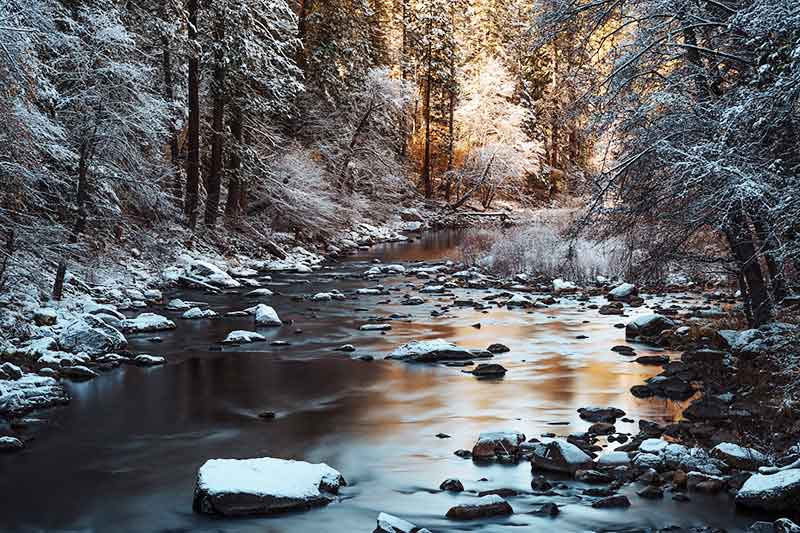The day begins with hours beside flowing water. The walk starts near the confluence of Tenaya Creek and Merced River. Late June, and the high country snow is fast disappearing, but the watersheds of both these streams still send down a generous flow, a gift of water I always consider particularly pleasing. Whenever I leave Yosemite I do it with full jugs, which remind me of this place whenever I drink.
Today I carry a liter of it in my pack while its generous source sails past as I walk upstream along the Merced. The trail is dusty, shaded, littered with horse droppings. The flow is rapid in this stretch and frequently squeezed along even faster by bouldered constrictions. It is absolutely transparent to its rocky bed and beautifully reflective of its surroundings: Stream flowing over bed of rocks that came from elsewhere and are now settled in place, stabilized though immersed in change. Water astonishes with its protean, forgiving, implacable nature; its manifold generosity seems endless, though 21st century humanity sorely tests it.
As I sit watching, it reminds me of a film reel, scene changing slightly with each frame. The ancient notion that “you never step into the same river twice” seems true only in a limited sense. Coursing water molecules are new every moment but they are only partial representation of river being. River begins in hidden notches at its highest reaches, gathers, welcomes feeder streams and meltwater all along the way, follows its bed (which persists even when water has temporarily dried), and forms a braid of continuity from beginning to end. It is whole with shifting aspects. I meet the same, though changed, River whenever I visit.
Zen master Shunryu Suzuki visited Yosemite Valley several decades ago. In Zen Mind, Beginner’s Mind, he speaks of Yosemite Falls and how it recalled to him other streaming water in his Japanese homeland. The book is a collection of his teachings, and one, “Nirvana, the Waterfall,” has had special meaning to me since I first read it. He tells of his former monastery and of two practices there: when Dogen-zenji dipped water from the river he always returned the unused portion back to the river; and when monks washed, they filled basins only partway and then emptied the water towards rather than away from their bodies.
This expresses respect for the water. This kind of practice is not based on any idea of being economical. It may be difficult to understand why Dogen returned half of the water he dipped to the river. This kind of practice is beyond our thinking. When we feel the beauty of the river, when we are one with the water, we intuitively do it in Dogen’s way. It is our true nature to do so.
…When we see one whole river we do not feel the living activity of the water, but when we dip a part of the water into a dipper, we experience some feeling of the water, and we also feel the value of the person who uses the water. Feeling ourselves and the water in this way, we cannot use it in just a material way. It is a living thing.
One knows: Water is, all that it is. I understand this response.
As I walk the two miles toward Vernal Fall the grade steepens, the bed narrows, and car-sized boulders become more common. Water is white with turbulence and alive with energy and grace as it surmounts and circles, bends to the rocks’ demands. Pools, eddies, chutes, and then at the Fall, splash, spray, mist; I’ve traveled from silence to cacophony, from transparency to prismatic colors as the rising sun plays with floating droplets.
I don’t remember when water began to affect me as it does now. It is difficult even to describe the effect. The material nature of water seems to manifest spirituality more than other substances, even when they assume the most striking forms. Valley wall formations, backcountry peaks and domes, forests and wildflower meadows: there is no resisting any of these, no doubt that they also speak clearly of invisible forces and realities (and of the water that has shaped or fed them). But there is something more in water that eludes me, something totemic.
Since I came upon it a couple decades ago, John Muir’s account of raindrops has remained my favorite expression of enchantment with water. He was enjoying his first time in the Sierra Nevada, in the high country north of Yosemite Valley; it was 1868. Thirty years old, he had recently arrived in California after a long trip begun by train from his home in Indianapolis to Louisville, followed by a long walk across Kentucky, Tennessee, Georgia, and into Florida. Laid low with malaria, he delayed for recuperation, and then continued by boat to Cuba where he stayed several weeks. Then to New York to catch another boat which took him to Panama, crossed the isthmus by train, and then on to San Francisco. Altogether, about a seven- month journey.
Muir had been in the mountains six weeks, a time of daily rapture as he immersed in the landscape, when a rain storm thundered in just after noon. “How interesting to trace the history of a single raindrop!” Two pages of lyrical transport combined with immense attentiveness to raindrop travels then follow. He reflected that the first such drops, geologic ages ago, fell on barren granite, but now they have peaks and domes, forest and garden, to receive them. Some join streams and lakes, falls and cascades, while others merge with meadow and bog where they “…creep silently out of sight to the grass roots, hiding softly as in a nest, slipping, oozing hither, thither, seeking and finding their appointed work.” Some sift downward through leaf and needle of tall trees while others attach to minerals and shine upon mates drumming through broad-leafed plants of countless varieties.
Some happy drops fall straight into the cups of flowers, kissing the lips of lilies. How far they have to go, how many cups to fill, great and small, cells too small to be seen, cups holding half a drop as well as lake basins between the hills, each replenished with equal care, every drop in all the blessed throng a silvery newborn star with lake and river, garden and grove, valley and mountain, all that the landscape holds reflected in its crystal depths, God’s messenger, angel of love sent on its way with majesty and pomp and display of power that make man’s greatest shows ridiculous.
Then the storm ends, “…and where are the raindrops now—what has become of all the shining throng? In winged vapor rising some are already hastening back to the sky…” Others are nurturing plants, or if they fell in the highest mountain reaches have locked into ice crystals; and finally many, through spring, stream, and river, make their way to ocean. “From form to form, beauty to beauty, ever changing, never resting, all are speeding on with love’s enthusiasm, singing with the stars the eternal song of creation.”
No one but John Muir can talk like this and get away with it. This and much more in similar vein are found in his My First Summer in the Sierra, which was my earliest encounter with him and it. I was enchanted and have remained so. When Martin Buber speaks of “hallowing the everyday,” this is one instance of what he means. When we speak of gifts and reciprocity, this exemplifies; mindful adoration is its highest expression. Water falls and flows, is drunk and absorbed, cleans and cools, moves in and out of countless forms and conditions, and yet, so far, it abides and continues to replenish. I sit by the Merced River, honoring the mystic flow.
Photo by Photo by Cedric Letsch on Unsplash


